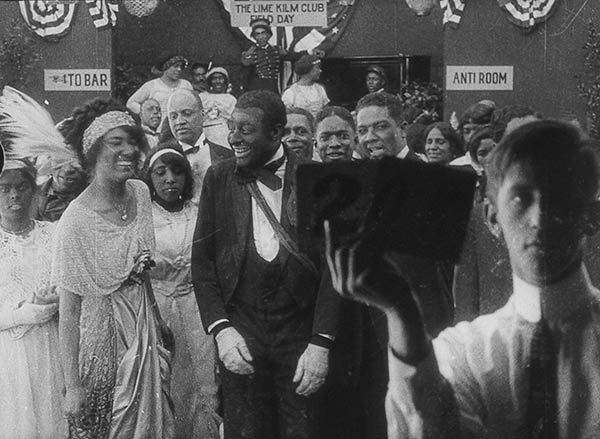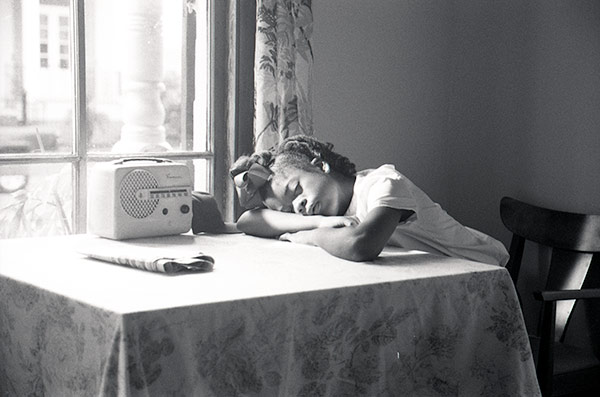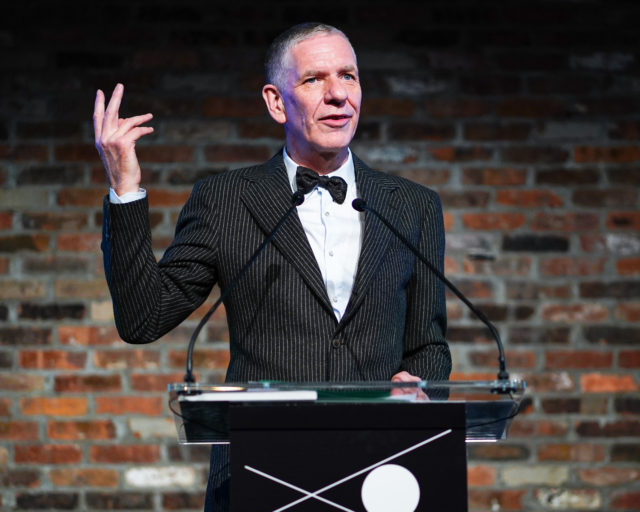Vision & Justice Online: 3 Reflections on Cinema and Archives
Catherine Gund, Shola Lynch, and Franklin Leonard discuss pioneers of cinema, African American archives, and the definitive films about black experience.
Still from An Oversimplification of Her Beauty, 2012
For Aperture’s “Vision & Justice” issue, groundbreaking filmmakers Ava DuVernay and Bradford Young speak about diversity and inclusion in Hollywood in “Black Lives, Silver Screen.” Here, Catherine Gund, Shola Lynch, and Franklin Leonard extend the conversation by reflecting on pioneers of cinema, African American archives, and the definitive films about black life and experience.

Catherine Gund
“Poets, prophets, and reformers are all picture-makers—and this ability is the secret of their power and achievements. They see what ought to be by the reflection of what is, and endeavor to remove the contradiction.” —Frederick Douglass
How could a feature film have changed the world? This is not a hypothetical question. What was possible one hundred years ago, before all that has happened since in the United States, in Hollywood, in our streets, in our minds? What can be seen (and imagined) now? How can we turn witnessing into guiding? Can artistic representation manifest fairness? Can we actually use media to create the world we want to live in?

In 1913, two years before the release of D.W. Griffith’s hideously racist Birth of a Nation, black and white people were making a silent film together starring Bert Williams entitled Lime Kiln Club Field Day. It was never finished, never shown, never seen. Its vision was unrealized, literally and profoundly. But unlabeled canisters full of outtakes—lost for a century—were recently discovered in the archives of the Museum of Modern Art. A thrilling find, a hint, an inspiration, a provocation because it was so unique. Here are everyday pictures of pleasure. Parades and picnics. Boy meets girl, gets girl, kisses girl by the front door. The dailies reveal what was a startling vision, a potential route forward in cinema toward equality, diversity, and justice. Except it was a path not taken. Lime Kiln Club Field Day, instead, remained in darkness, buried under this country’s doctrines of dehumanization, segregation, violence, and a powerful mainstream media machine.
Louisiana-based artist and filmmaker Garrett Bradley is exploring that repressed path of social progress, reimagining not only the disappeared parts of Lime Kiln, but also some of the other seventy percent of silent films from that era which are missing, deteriorated, destroyed. Her project American Rhapsody is a series of twelve silent, black-and-white, 35mm films set between the years 1915 and 1926. Each of the films represent experiences in everyday black life against the backdrop of ordinarily extraordinary things like the establishment of the forty-hour work week, the Negro League, the radio, and Daylight Saving Time. I am coproducing this series with Lauren Domino because there is a thin layer of history that can be mined for justice and joy. The three of us are going there, and asking: How do we understand the past? What is media’s power to change the course of history? And how can we consider race differently as we move forward as a society?

As Garrett writes, “The suppression of this time period, and consequently, its invisibility a century later, poses a unique opportunity for visual recreation. We are interested in creating original visions of a radical and integrated past, through a showcase of brilliant, silent performances, and most poignantly, visual depictions of joy. The heart and soul of American Rhapsody will ask viewers to evaluate the role of pleasure, particularly within communities still in some ways barred from that fundamental experience, through excessive labor, control, and disenfranchisement. American Rhapsody aims to reveal the simplicity of pleasure that can exist in the everyday, in our own here and now.”
Catherine Gund is a filmmaker, activist, and founder of Aubin Pictures.
Shola Lynch
The archive is a place of vision, justice, and activism. At least it is at the Schomburg Center for Research in Black Culture in New York City. The Library’s Afro-Puerto Rican founder and first curator, Arturo Alfonso Schomburg, began collecting books and manuscripts because, as a child, a teacher had told him that blacks had no history or heroes. While he didn’t believe it, he had no information, anecdote, or proof to the contrary. This experience shaped him and how he saw the world around him.
Schomburg moved to Harlem in the 1890s. He worked downtown as messenger and clerk to support his family. Uptown, through clubs and politics, he helped to usher in in the intellectual and cultural Harlem Renaissance. He spent any extra time and money on collecting works by and about black people globally.

Instead of only arguing against the myth of Negro inferiority, Schomburg systematically amassed proof of black history and achievement. In his 1925 essay, “The Negro Digs Up His Past,” he identified his activism by describing the objects he collected as “vindicating evidences.” Schomburg purchased books, pamphlets, prints, and photos from all corners of the world, and enlisted his globetrotting Harlem Renaissance social network to help. He became known as the collector. What began as a personal quest manifested into a collection of some ten thousand items, which, since being purchased by the New York Public Library in 1926, has blossomed into more than ten million books, manuscripts, art objects, photographs, prints, motion pictures, and audio recordings—all “vindicating evidences.”
“The American Negro must remake his past in order to make his future,” Schomburg wrote in 1925. His vision and activism was to make this true, and to personally inspire a generation of scholars through the Library as an institution and a destination. Likewise, as an individual filmmaker, I contribute to the cause by telling one story at a time. But as a Curator of the Moving Image & Recorded Sound Division, I continue Schomburg’s mission more broadly. The collections inspire legions of storytellers, across disciplines from academics to filmmakers and artists, to continue to sculpt and rediscover the narrative and nuances of black history.
Schomburg asks us to know ourselves through history’s evidences, and to use them as a tool to claim our cultural legacy and historical ancestors—to know our history and heroes. By providing the raw materials, his collection has established and reshaped the narrative of black history, and continues to do so today.
Shola Lynch is the Curator of the Moving Image and Recorded Sound division at The New York Public Library’s Schomburg Center for Research in Black Culture. Among her many works, she is best known as the director of Chisholm ’72–Unbought & Unbossed (2004) and Free Angela and All Political Prisoners (2012). She was also recently named as a member of the Academy of Motion Picture Arts & Sciences.
Franklin Leonard
“I’m not saying I’m gonna change the world, but I guarantee that I will spark the brain that will change the world.” —Tupac Shakur, 1997

WITHIN OUR GATES. BODY AND SOUL. GOD’S STEPCHILDREN. THE BLOOD OF JESUS. BLACK GIRL. THE LEARNING TREE. WATERMELON MAN. SHAFT. SWEET SWEETBACK’S BAADASSSSSS SONG. SUPER FLY. THE SPOOK WHO SAT BY THE DOOR. TOUKI BOUKI. COOLEY HIGH. MAHOGANY. UPTOWN SATURDAY NIGHT. XALA. CAR WASH. KILLER OF SHEEP. ASHES AND EMBERS. LOSING GROUND. SUGAR CANE ALLEY. KRUSH GROOVE. THE LAST DRAGON. HOLLYWOOD SHUFFLE. I’M GONNA GET YOU SUCKA. A DRY WHITE SEASON. DO THE RIGHT THING. HOUSE PARTY. MO BETTER BLUES. TO SLEEP WITH ANGER. BOYZ IN THE HOOD. DAUGHTERS OF THE DUST. JUNGLE FEVER. NEW JACK CITY. BOOMERANG. JUICE. JUST ANOTHER GIRL ON THE IRT. MALCOLM X. MENACE 2 SOCIETY. SANKOFA. CROOKLYN. I LIKE IT LIKE THAT. DEVIL IN A BLUE DRESS. FRIDAY. WAITING TO EXHALE. THE WATERMELON WOMAN. EVE’S BAYOU. LOVE JONES. SOUL FOOD. THE BEST MAN. BAMBOOZLED. LOVE AND BASKETBALL. LUMUMBA. FAAT KINÉ. 25TH HOUR. MOOLADÉ. BAMAKO. MEDICINE FOR MELANCHOLY. HUNGER. PRECIOUS. NIGHT CATCHES US. SUBMARINE. I WILL FOLLOW. PARIAH. RESTLESS CITY. AN OVERSIMPLIFICATION OF HER BEAUTY. MIDDLE OF NOWHERE. 12 YEARS A SLAVE. BIG WORDS. LEE DANIELS’ THE BUTLER. MOTHER OF GEORGE. BELLE. BEYOND THE LIGHTS. DEAR WHITE PEOPLE. FRUITVALE STATION. SELMA. TIMBUKTU. TOP FIVE. BESSIE. CHI-RAQ. CREED. DOPE. STRAIGHT OUTTA COMPTON. BIRTH OF A NATION. HOW TO TELL YOU’RE A DOUCHEBAG. MILES AHEAD. MOONLIGHT. THE LAND. UNITED KINGDOM.
Franklin Leonard is Founder and CEO of The Black List.
Read more from “Vision & Justice” or subscribe to Aperture and never miss an issue.

























